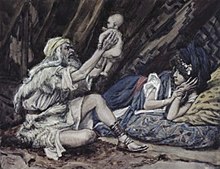|
Lamech (father of Noah)
Lamech (/ˈleɪmɪk/;[1] Hebrew: לֶמֶךְ Lemeḵ, in pausa לָמֶךְ Lāmeḵ; Greek: Λάμεχ Lámekh) was a patriarch in the genealogies of Adam in the Book of Genesis. He is part of the genealogy of Jesus in Luke 3:36.[2] Lamech (Arabic: لامك, romanized: Lāmik) is also mentioned in Islam in the various collections of tales of the prophets who preceded Muhammad, which mentions him in an identical manner.[citation needed] Bible narrative
Biblical genealogyLamech is the eighth-generation descendant of Adam (Genesis 5:25), the son of Methuselah, and the father of Noah (Genesis 5:29), in the genealogy of Seth in Genesis 5. In Genesis 5:12-25, Lamech was a son of Methuselah, who was a grandson of Jared, who was a grandson of Kenan descended from Adam.[3] Genesis 5:28–31 records that Lamech was 182[4] (according to the Masoretic Text; 188 according to the Septuagint[5]) years old at the birth of Noah and lived for another 595[5] years, attaining an age at death of 777[5] years, five years before the Flood in the Masoretic chronology. With such numbers in this genealogical account, Adam would still have been alive for about the first 56 years of Lamech's life.
Prophetic namingWhen Lamech named his son Noah, he prophesied: "This [same] shall comfort us concerning our work and toil of our hands, because of the ground which the LORD hath cursed." (Genesis 5:29) The people were cumbered with the toil of cultivating a ground that had been cursed in Genesis 3:17, and they hoped for relief through Noah. Albert Barnes noted: "In stating the reason of the name, they employ a word which is connected with it only by a second remove. נוּח nûach and נחם nācham are stems not immediately connected; but they both point back to a common root נח (n-ch) signifying 'to sigh, to breathe, to rest, to lie down.'"[6] At Noah's sacrifice in the new world after the flood, the LORD said, "I will not again curse the ground any more for man’s sake; for the imagination of man’s heart [is] evil from his youth; neither will I again smite any more every thing living, as I have done."[7] TombAccording to a local Afghan legend, Lamech was buried 50 km (31 mi) from Mihtarlam. Ghaznavid Sultan Mahmud of Ghazni built a tomb and gardens over the presumed burial site. Mihtarlam itself is said to be named after Lamech.[8][9] In popular cultureLamech is portrayed by Marton Csokas in the 2014 film Noah, handing his son the skin of the serpent who tricked Adam and Eve to eat the Forbidden Fruit in the Garden of Eden, before he is murdered by Tubal-cain with a battle axe. References
|
||||||||||||
